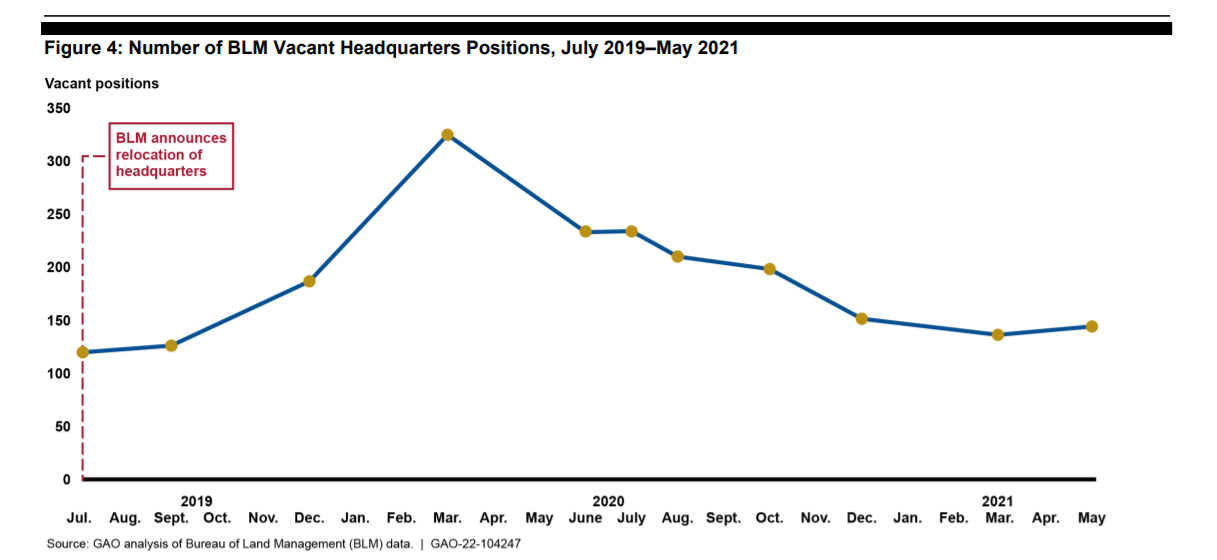Vacancies persist after BLM relocation drove experienced, diverse employees from agency, GAO finds
Vacancies jumped from 121 open positions in July 2019, when the Bureau of Land Management first announced the relocation, to 326 in March 2020, a 169% increase,...
About 76% of the Bureau of Land Management employees picked to relocate from Washington, D.C. to Colorado or new locations out west declined their reassignments or left the agency before receiving notices of the move, and recent data shows the agency is still struggling to recover.
Just 41 employees, or 23% of the remaining staff BLM selected to move to Grand Junction, Colorado, or 11 western states in 2019 accepted their reassignments, the Government Accountability Office said Thursday in a new report on the relocation.
About 134 positions were vacant before the BLM relocation.
Interior Secretary Deb Haaland has since said she will move the BLM headquarters, along with several senior officials, back to Washington, D.C. But the relocation, which GAO said the bureau completed without a strategic workforce plan, had and continues to have an impact on BLM employees.
Vacancies jumped from 121 open positions in July 2019, when the Interior Department first announced the BLM relocation, to 326 in March 2020, a 169% increase, according to GAO.
By January of this year, the BLM headquarters workforce was 18% smaller than it was before the relocation occurred, a number that reflects employees who left the bureau because of the move and reallocating positions to state offices.

BLM had 142 vacancies as of May 2021, the most recent data available. That number reflects a headquarters workforce that is 17% smaller than when the agency announced the BLM relocation in July 2019.
“Some of the staff members we interviewed said that the lack of information sharing with staff about the move west was a challenge,” GAO said. “For example, one staff member said that BLM leadership made relocation decisions ‘behind closed doors’ and without manager or employee input, and another staff member described an atmosphere where staff were discouraged from asking questions about the move.”
The BLM relocation itself isn’t the sole reason for vacancies within the bureau, but other factors made filling those positions more difficult once Interior announced plans for the move.
A 2017 hiring freeze, which the Trump administration implemented during its first days in office, prevented BLM from vacant positions open through attrition. The bureau also implemented other hiring freezes on more senior positions over the last several years, GAO said.
The vacancies made it difficult to create or clarify regulations and policy, BLM staff told GAO.
And while the bureau frequently used temporary assignments and details to fill open headquarters positions, nearly all of the 13 BLM employees GAO interviewed said the reliance on that tool negatively impacted their office’s performance in some way.
“For example, one staff member said that BLM detailed too many staff at a given time, which led to some confusion and inefficiency,” GAO said. “Another staff member described a ripple effect where details of state office staff to headquarters led to reduced capacity in state and field offices.
Data shows BLM also lost more tenured staff over the last five years. Employees with 25 years or more of experience made up 24% of the BLM workforce in January 2016 compared to 17% in January 2021, GAO said. The problem was worse within BLM headquarters, where the number of employees with 25 years of experience declined by 34% over that time period.
The loss of experienced staff made it more difficult, for example, for BLM to provide input on proposed rules and legislation.
Representation of certain racial and ethnic minorities also varied over the last five years, GAO said. The percentage of white BLM employees fell by 2% between January 2016 and 2021, and the number of Black and African American employees decreased by 6% during that period.
In contrast, the number of Hispanic and Latino employees increased by 17% over the last five years, and representation of Asian employees improved by 18%, according to GAO.
Diversity worsened, however, inside BLM headquarters, where representation of Black and African American employees fell by more than half, GAO said. In July 2019, 116 of BLM’s 561 headquarters employees, or 21%, were Black or African American.
After the relocation was complete in January 2021, Black or African American employees made up 12% of the BLM headquarters workforce, or 55 of 443 people, GAO said.
The bureau’s headquarters workforce saw similar declines in representation among Asian employees during the BLM relocation, while representation among white employees increased during that time, growing from 67% to 74%.
In announcing the BLM relocation two years ago, the bureau previously said the moves would realize cost savings and lower travel expenses — and would ultimately bring more employees closer to the resources they manage.
But BLM executed the relocation without a comprehensive strategic plan, one that tracked the bureau’s programs for acquiring, developing and retaining staff with its broader mission goals.
GAO recommended BLM develop a strategic workforce plan, which the bureau still lacks. It also suggested BLM better track details and temporary assignments among state offices and headquarters.
Interior agreed to both recommendations.
Copyright © 2025 Federal News Network. All rights reserved. This website is not intended for users located within the European Economic Area.
Nicole Ogrysko is a reporter for Federal News Network focusing on the federal workforce and federal pay and benefits.
Follow @nogryskoWFED







